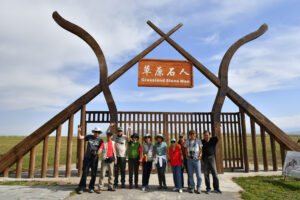
About Shengyou Temple
Shengyou Temple stands as a testament to the rich cultural tapestry of Xinjiang's Ili region. This Buddhist sanctuary, tucked away in the remote Zhaosu County, offers visitors a unique blend of spiritual serenity and historical intrigue. As you approach the temple, you're greeted by the distinctive architecture that characterizes Buddhist temples in this part of China. The structure's design reflects the fusion of traditional Chinese and local Mongolian influences, a visual representation of the area's diverse heritage. Inside, the temple houses a collection of revered Buddhist artifacts and intricate artwork. The air is thick with the scent of incense, and the soft chanting of monks often fills the halls, creating an atmosphere of profound tranquility. It's a place where time seems to slow, allowing visitors to immerse themselves in quiet contemplation. What sets Shengyou Temple apart is its location in the heart of Zhaosu County, an area known for its breathtaking landscapes and nomadic culture. The temple serves as a spiritual anchor in a region where Buddhism and local traditions have intertwined for centuries. Visitors have the rare opportunity to witness how these beliefs coexist and influence each other in this remote corner of China. For those planning a visit, it's worth noting that the temple's remote location means facilities are basic. However, this adds to its charm and authenticity. The journey to Shengyou Temple is as rewarding as the destination itself, offering glimpses of the stunning natural beauty and pastoral life of Xinjiang. Whether you're a spiritual seeker, a history enthusiast, or simply a curious traveler, Shengyou Temple provides a window into a lesser-known facet of China's religious and cultural landscape. It's a place where the ancient and the eternal converge, offering visitors a profound and memorable experience.Shengyou Temple stands as a testament to the rich cultural tapestry of Xinjiang’s Ili region. This Buddhist sanctuary, tucked away in the remote Zhaosu County, offers visitors a unique blend of spiritual serenity and historical intrigue.
As you approach the temple, you’re greeted by the distinctive architecture that characterizes Buddhist temples in this part of China. The structure’s design reflects the fusion of traditional Chinese and local Mongolian influences, a visual representation of the area’s diverse heritage.
Inside, the temple houses a collection of revered Buddhist artifacts and intricate artwork. The air is thick with the scent of incense, and the soft chanting of monks often fills the halls, creating an atmosphere of profound tranquility. It’s a place where time seems to slow, allowing visitors to immerse themselves in quiet contemplation.
What sets Shengyou Temple apart is its location in the heart of Zhaosu County, an area known for its breathtaking landscapes and nomadic culture. The temple serves as a spiritual anchor in a region where Buddhism and local traditions have intertwined for centuries. Visitors have the rare opportunity to witness how these beliefs coexist and influence each other in this remote corner of China.
For those planning a visit, it’s worth noting that the temple’s remote location means facilities are basic. However, this adds to its charm and authenticity. The journey to Shengyou Temple is as rewarding as the destination itself, offering glimpses of the stunning natural beauty and pastoral life of Xinjiang.
Whether you’re a spiritual seeker, a history enthusiast, or simply a curious traveler, Shengyou Temple provides a window into a lesser-known facet of China’s religious and cultural landscape. It’s a place where the ancient and the eternal converge, offering visitors a profound and memorable experience.
Location
Places to Stay Near Shengyou Temple
Find Tours in Ili
Explore More Travel Guides
No reviews found! Be the first to review!

